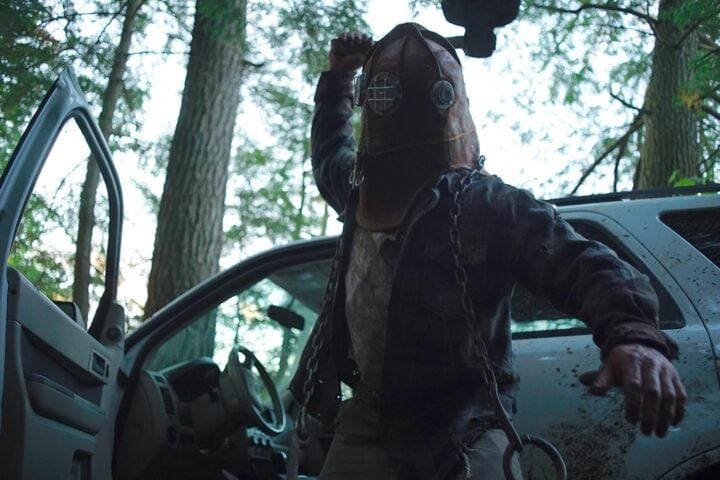Writer-director Chris Nash’s feature directorial debut, In a Violent Nature, opens in eerie serenity, with a gorgeously layered image of a forest seen through a deteriorated window frame. Birdsong and gentle breezes take aural precedence, though there are off-screen human voices of an evidently teen-to-twentysomething variety that clash discordantly with all the verdant beauty. The camera eventually tracks laterally, rack-focusing to reveal a locket hanging around a pipe. A hand enters frame, removing the bauble from its perch. Big mistake, as evidenced by the psychotic demon that soon emerges from the peaty earth below.
This is Johnny (Ry Barrett), a hulking, skin-mottled figure so obviously inspired by Friday the 13th’s Jason Voorhees that the hockey-masked undead spree killer could sue for residuals. But Nash and his crew aren’t out to brazenly imitate their forbear so much as affectionately and provocatively rework him and his murderous exploits. The quite ingenious conceit here is to filter slasher-flick tropes and story mechanics through an arthouse-cum-slow-cinema prism. Think Béla Tarr doing an unholy doc-fiction hybrid about Camp Crystal Lake.
In this strange universe, Johnny is the protagonist, the camera following him mostly from behind in steady medium profile as he stalks through the woods on an infernal fetch quest. That stolen locket is the goal, and the flora and fauna are his cheering squad. There isn’t any score of the breathlessly insistent kind that typified the Friday the 13th series. The trickle of running water or the crush of leaves underfoot is music enough. Even with a reanimated corpse as the focus, the lengthy strolls through the countryside prove very lulling and pleasing. It would hardly be surprising if David Attenborough popped in to narrate all the lush (in)action.
Nash has other disruptions in mind, and ones more appropriate to the genre on which In a Violent Nature is riffing. In the early going, jump cuts are utilized to move Johnny between locales, as well as to expressively imply the gruesome horror of the first (off-screen) kill of a redneck hunter (Timothy Paul McCarthy) who’s a little too in love with his animal traps.
Soon after, when Johnny stumbles across the campers who are his primary targets, the film settles into a talky expositional groove. But it’s one that’s juiced by the ceaselessly circling camera and the unsettling sense that the twentysomethings—smartphone users and cancel-culture discoursers whose looks and cadences nonetheless straddle the ’80s and ’90s—don’t seem to fit into any era. There’s a timelessness to the film that augments its allegorical qualities with Johnny as a mythic monster unleashed time and again by manmade upheaval.
Johnny’s savagery interestingly loses its anxiety-inducing edge as In a Violent Nature goes on. The violence he unleashes, even at its most hilariously over the top, perversely comes to seem natural. Weird thing to say, perhaps, about a three-quarters decapitation just above the tongue, or a brain-splattering boulder to the face, or a body-breaking bit of business best described as “the yoga kill.” Yet these are far from the adrenaline-rushing cheap frights of the Friday the 13th series, which admittedly do have their own internal logic and poetry.
In a Violent Nature’s concerns are as thrillingly cryptic and evocative as those of Hamaguchi Ryûsuke’s horror film-adjacent eco-parable Evil Does Not Exist. After an hour-plus of Johnny’s splatterific bloodletting, only this flesh-rotted executioner and shellshocked final girl Kris (Andrea Pavlovic) remain. A vengeful and conflagratory battle appears to be in the offing. But then Kris makes a choice far removed from what a character in her position might normally do, seemingly breaking the cycle of violence. More likely, she defers the surely apocalyptic consequences of Johnny’s rabid resurrection to some not-so-distant future date.
The climax is then daringly given over to an extended conversation between Kris and her rescuer, a woman played in a pointed bit of meta-casting by Friday the 13th: Part 2’s Lauren-Marie Taylor, about the oft-inexplicable interplay between the human and natural worlds. It’s a curveball that feels exactly right in context and fully in conversation with the film’s many unnerving aesthetic and thematic ambiguities. All the verbal hemming and hawing soothes us into complacency only to then jolt us awake via an all-pervasive climate of unease. For the film’s final moments suggest that the beast made flesh has become one with the elements and—much like nature with all its concomitant ecstasies and agonies—is now inescapable.
Since 2001, we've brought you uncompromising, candid takes on the world of film, music, television, video games, theater, and more. Independently owned and operated publications like Slant have been hit hard in recent years, but we’re committed to keeping our content free and accessible—meaning no paywalls or fees.
If you like what we do, please consider subscribing to our Patreon or making a donation.





